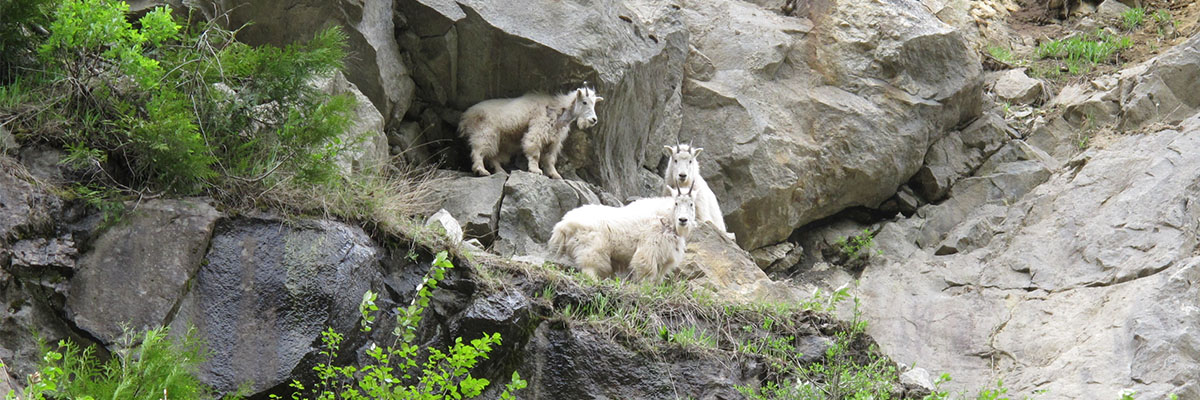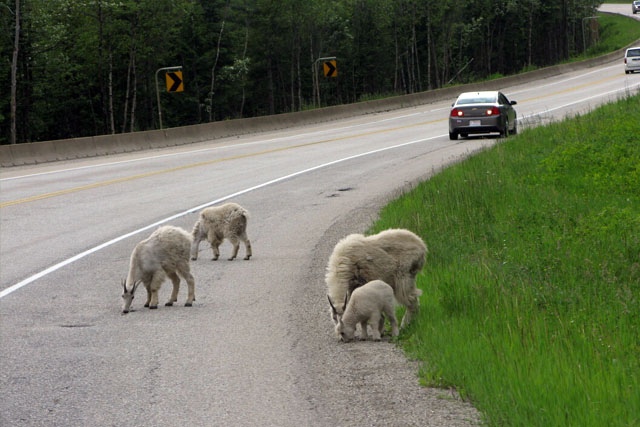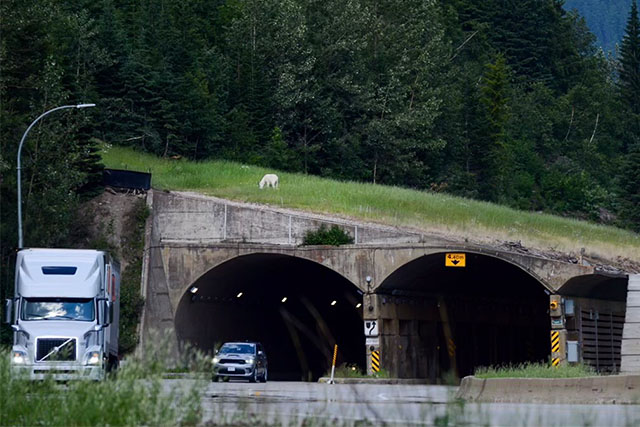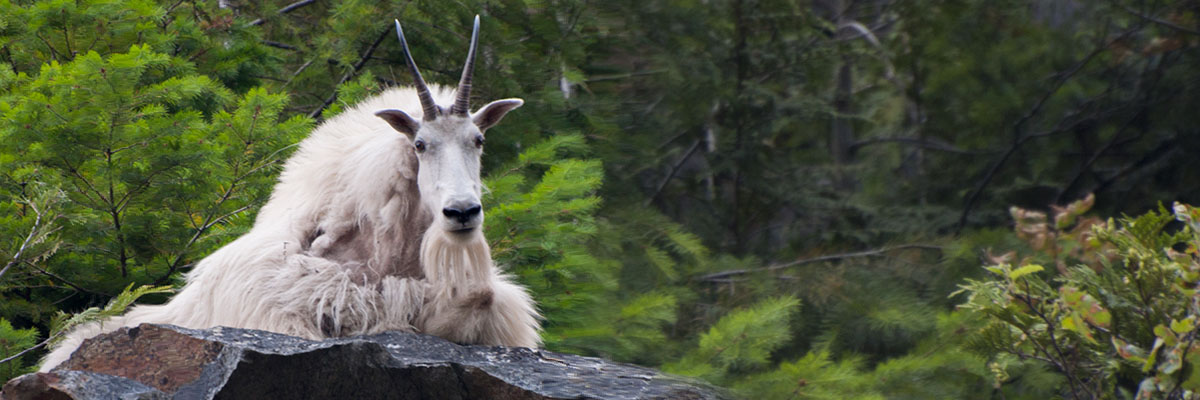
Mountain goats
Mount Revelstoke National Park
Quick facts
Eats grasses, lichens, mosses, sedges and flowering plants
Weighs Males 80 - 100 kg, Females 60 - 80 kg
Sounds include huffing and snorting, high-pitched mewling
Fur is made up of thick woolly undercoats and outer guard hairs of up to 20 cm (8") in length. Goats can withstand temperatures as low as -50°C!
Horns are made of keratin, similar to fingernails, and continue to grow throughout the animal's life. Both males and females have horns.
Lives 12 - 14 years
Able to scale seemingly sheer cliffs and perform acrobatic feats on narrow ledges, mountain goats are nature's true mountaineers. Being able to live in steep mountainous terrain helps mountain goats avoid predators. While wolves, cougars and bears can still be a threat to mountain goats, the terrain they live in is in itself a threat, particularly with rock slides and avalanches.
Where they live
Mountain goats are only found in the mountain ranges of western Canada (Alberta and British Columbia) and the northwestern United States (Alaska, Washington, Montana, Idaho and Oregon). About 50% of them live in British Columbia, including in Mount Revelstoke and Glacier national parks.

Why did the goat cross the road?
To get some salt to go with their spring greens! In spring and summer, mountain goats in Mount Revelstoke and Glacier national parks sometimes descend to areas along the Trans-Canada Highway to feed on fresh vegetation along the side of the road and to lick salt off the shoulder and road surfaces. Mountain goats are expert mountaineers. They can scale seemingly sheer cliffs and perform acrobatic moves on narrow ledges. Unfortunately, these mad skills don’t apply to safely crossing a busy national highway. Being on or near the road puts them at risk of being hit by vehicles.
As traffic volumes continue to increase, it becomes harder and harder for wide-ranging species like mountain goats, caribou and bears, to cross the highway. The ultimate goal for Mount Revelstoke and Glacier national parks is to reconnect the landscapes that have been impacted by the highway. A variety of actions are taking place towards this goal including some projects just for mountain goats.
What is Parks Canada doing?
Finding ways to connect landscapes so that mountain goats can get what they need and where they want to go without crossing the highway supports survival of the Mount Revelstoke and Glacier populations. Reducing the risk of collisions is important for the safety of goats and motorists on the Trans-Canada Highway.
Diversionary salt licks

Within Mount Revelstoke and Glacier national parks, there are several areas where goats are known to descend to the highway for salt. As a short term solution for those areas, artificial mineral licks are being placed above the highway. Special salt intended for animal consumption is added to the soil in areas along the goat trails to give them a chance to obtain salt before they reach the highway. As part of this project, natural mineral licks will be identified and their soil analyzed to help us give mountain goats the right mix of minerals at the diversionary licks. Only gourmet Columbia Mountains mineral blend for these kids!
Note: Do not feed goats, or any other wildlife. This project is conducted under strict wildlife management protocols to ensure that goats do not see people as sources of food and become habituated!
Habitat mapping

To find long-term solutions, it is important to learn where mountain goats want to be in different seasons in Mount Revelstoke and Glacier national parks. Knowing where their important habitat is can help identify where actions might be needed to ensure they can access what they need in all seasons. This might include either keeping them off or helping them cross the Trans-Canada Highway. Finding out where they go is no easy task, however, unless you’re a mountain goat. Parks Canada maintains a network of remote wildlife cameras throughout Mount Revelstoke and Glacier national parks. The cameras are part of a project to monitor wildlife distribution throughout the parks. While not set up specifically for mountain goats, photos of goats captured on the cameras give a glimpse of when and where they travelled through. There are also nine mountain goats in the parks outfitted with GPS collars. The GPS collars provide location information for each goat every few hours. Important winter habitat for goats has been mapped through analysis of the collar data. The GPS collar data will also also be used to map summer habitat, including important resources like mineral licks.

What can you do?
Learn more about mountain goats
- Stop by the Rogers Pass Discovery Center and check out the interpretive display on mountain goats including an upcycled goat sculpture!
Is that a goat?
- If you see goats, give them space! Stay at least 100m away.
- Do not follow tracks. Goats are especially sensitive to disturbance in winter. Food is scarce and they need to move as little as possible to conserve energy.
- Never feed wildlife (keep food and other wildlife attractants safely stored even in winter!)
- Keep pets on leash at all times.
Driving through the parks
- Always obey posted speed limits. Slow down if conditions and/or visibility deteriorate.
- If you see wildlife, slow down, stay in your vehicle and move on. Pulling over to observe wildlife on roads is hazardous. Stopping in the middle or along the side of the road puts yourself, wildlife and other motorists at risk. It teaches animals that vehicles on highways are nothing to be afraid of. In Parks Canada’s protected places, too many animals are killed along highways each year. Pulling over is also dangerous because stopped vehicles become visual obstructions for other drivers.
- If you observe mountain goats on or near the highway in Mount Revelstoke or Glacier national parks, report the sighting to Parks Canada dispatch (1-877-852-3100).
- Date modified :